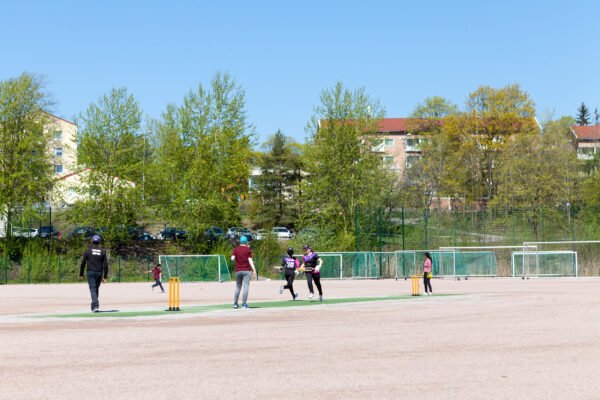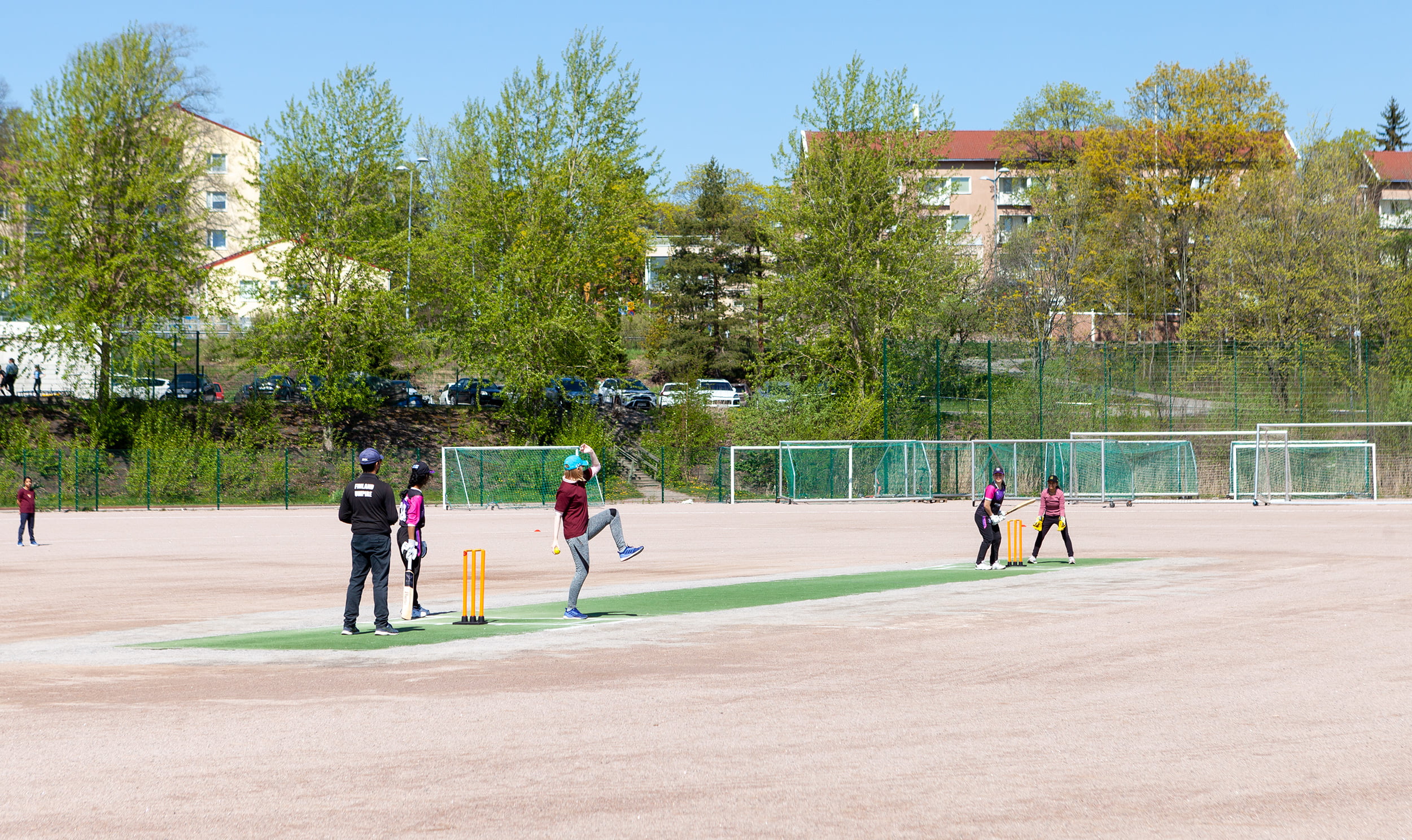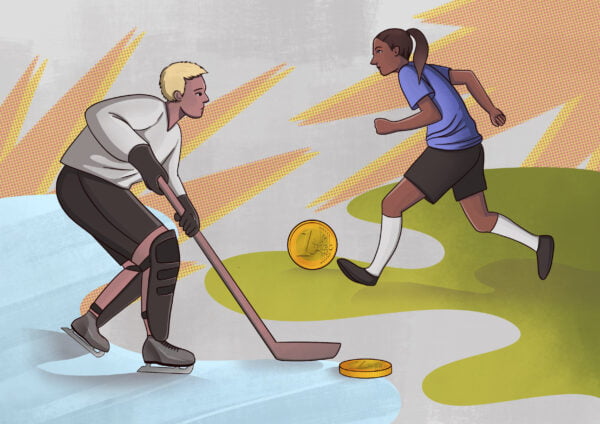It’s a beautiful Saturday in April at the Käpylä sports park in Helsinki. There is a group of women on the field, some of whom I think I recognize from the profile pictures in the Whatsapp group. Further back, the men’s team is already training near the cricket pitch partially protected by nets. The bowler rushes the ball with a strange but fast technique towards the batter inside the batting cage. The bowler’s arms spin like the blades of a crazed windmill.
I have arrived at the first training session of the newly established women’s team of the cricket club SKK, Stadin ja Keravan Krikettiseura. In May, we are going to play in the first ever women’s cricket championship league game in Finland.
Cricket, which originates from Britain, is a bat-and-ball game and a distant cousin of baseball. Cricket is especially popular in the Commonwealth countries and although it is the second most popular sport in the world after football, it is still quite unknown in Finland. Here it is often confused with, for example, croquet and – for some strange reason – horse polo.
However, cricket has been played in Finland for a long time already, whole decades before the official sports association was founded in 1999. At the time, by the demands of the International Cricket Council ICC, the Finnish League was quickly established with a total of four teams. Currently there are 35 clubs in Finland with the northernmost club in Oulu.
Maija Scamans, the Development Director of the Finnish Cricket Association, has been involved in the sports association since the beginning. Women started playing cricket in a more organized way at the beginning of the millennium. ”In the summer of 2000, we sat at the White Lady restaurant in Ruskeasuo and raised a toast to women’s cricket. In the following spring there was a beginners’ course, and then a team was founded,” recalls Scamans.
Moneygame
At the top of the hierarchy in the International Cricket Council are the big cricket countries, which dominate the longest format of the game, test cricket. These countries include Australia, England, South Africa, India, Pakistan and the West Indies. The ICC encourages its members to develop junior cricket and women’s leagues, but any tangible help for the smaller member countries is minimal. Scamans says that it requires quite the pioneer spirit to make way for cricket. ”Internationally we are fighting for attention with the big countries, and then again with all the other sports here in Finland. In other words, we are small both globally and locally,” says Scamans.
However, Finnish cricket had a surprising moment in the limelight during the COVID-19 pandemic. Cricket leagues around the world were put on hold due to the outbreak and in the summer of 2020 the game was only being played in Vanuatu and Finland. When the word got around that the Finnish League games had started, an international production team arrived to stream the games, and Finland instantly shot to the center of attention within the international cricket scene. Bookies took interest also. At the Kerava field there were strangers hanging around reporting the events live over the phone to Indian bookies. Players were approached with murky suggestions.
There is indeed a lot of money in cricket. Currently, especially the super rich in India are spending a lot of money on the Indian Cricket League, but also on the cricket leagues of other countries. It’s about money and soft power – but also about the love of the sport. SKK Chairman Ponniah Vijendran says that, for example, Microsoft CEO, cricket fan Satya Nadella is a major investor in the sport. ”There is a huge number of skilled players coming from the Indian subcontinent, because there everyone plays cricket and everyone is passionate about it,” says Vijendran.
He points out that people from big cricket countries also spread the game around the world. ”India, Pakistan, Bangladesh, Sri Lanka, Nepal and Afghanistan are countries where cricket is the number one sport and that diaspora is growing the game.”
Maija Scamans says that it has recently dawned on the ICC that there could be money made in women’s cricket as well. That is also, or perhaps precisely why the ICC has encouraged national sports associations to invest in women’s cricket. In addition to the very first women’s championship league games in Finland, a women’s national team will be established. The Nordic Women’s Cricket Tournament will be organized in Kerava at the end of August.
Inadequate infrastructure
We start with the basics on the Käpylä field. Basically, there are three player roles in cricket: bowler, batter and fielder. The team utilizes each player’s individual strengths. The bowler – with the ball bouncing on the ground once – tries to hit the wickets behind the batter and break them, while the batter tries to protect the wickets and at the same time get runs by hitting the ball as far as possible.
Areeb Quadir, the coach of the SKK women’s team – and a batter in the men’s national team – has us playing catch. Ball handling is an important skill in cricket. Skilled bowlers are worth their weight in gold, yet fielders can get the batter out by catching the ball right out of the air. Unlike in baseball, no gloves are used in cricket. The hard ball is caught with bare hands.
In principle, cricket is not equipment heavy. To play, you only need a ball and something flat like a bat, even just a piece of board. That is how cricket is played in many corners of the world. But if a player is serious about improving the skills, infrastructure begins to matter.
Ponniah Vijendran says cricket in Finland is hampered by the lack of proper infrastructure. The outdoor playing season is short and even then there are only a few suitable fields. The Kerava field is Finland’s only purposely built grass field for cricket that meets international standards. Another field that meets international standards is in the Tikkurila Sports Park.
In Käpylä, the game is played on a gravel court with a strip of artificial grass in the middle. The field does not offer any other enhancements for cricket enthusiasts. The players bring the necessary safety nets with them for training sessions and build and dismantle them every time.
But at least there are places to play in the summer. In the winter, the situation is different.
During the winter season the sport is played in sports halls in the capital region, but at the moment the only permanent indoor practice facility for cricket is in Eerikkilä near Forssa about an hour’s drive from Helsinki. Cricket Finland co-operates with capital area cities with the goal of acquiring new indoor facilities. Vijendran and his business partners have started a company called Playbox Oy, and their first aim is to open a fit for purpose indoor sports hall for cricket and other ball sports near Itäkeskus.
Scamans says that the biggest obstacle to the growth of cricket in Finland is attracting new enthusiasts to the little-known sport. When I ask her what fascinates her about cricket, Scamans mentions two things: the versatility of the game and the sense of community. ”It’s a team game made up of individuals, where you must take everyone into account. You perform individually in batting and bowling and then of course there is the field game. And initially I fell in love with the communal nature of the sport.”
Cricket as a community
Our varied team immediately finds common ground. Some of the women have recently arrived in Finland for work whilst some have grown up in the country. Everyone has fun batting and bowling. At a safe distance, there are children running around on the field.
Some of the cricket clubs in Finland have players mainly from a certain country, but SKK, for example, is a so-called mixed club with players from about a dozen different nationalities, including Finns. ”I would never have met such a diverse group of people in Britain in my own circles,” says Ponniah Vijendran. The team has those who have fled genocide as well as those who have attended prestigious private schools in the UK. Everyone is united by the love of cricket.

There are very few fitness or other physical requirements in cricket, but it does take years to develop the required skills. And since almost everyone who plays in the men’s teams here in Finland has been playing cricket for a long time – or all their lives – complete beginners may find it intimidating to join in.
But inexperience is not a problem in the women’s team. Almost every single member in our new team is a complete beginner, although some have played cricket in their childhood and also watched a lot of cricket.
Play Cricket Suomi, PCS, is a club in Finland that is focused on women’s and junior cricket. In the Finnish women’s league in addition to the two PCS teams, we will face the Empire Cricket Club’s women’s team.
We are clearly the underdog, but when the day arrives, all that are able, show up in cheerful spirits. However, we do watch the first game of the day between PCS1 and Empire with a bit of horror. Some of the women in the other teams have been training for years.
The burn
In the first game, we start with fielding. Considering the short training period, we are doing a reasonably good job bowling, and some of my teammates are actually quite good. Even if I don’t get enough speed or power into my bowling, the ball still goes in the right direction and far enough whenever I don’t think about it, but let my upper body and especially my straightened right arm to do all the work. Sometimes I’m lost, I don’t run after the ball when I should, and when I have the opportunity to try to catch the ball from the air and get the batter out, my self-preservation instinct tells me to dodge instead. I obey. It reminds me of school volleyball.
The umpires and the Empire team players give me advice when I ask stupid questions. The friendly opposition even gives me tips on aiming. Keep your eyes on the batter’s shoes. When the teams switch sides and it’s my turn to bat, the wickets behind me break straight away with the first try and I’m out. And so annoyed.
We lose the first game against Empire as expected. Regardless, everyone in our team wants to get back in the field soon.
We also lose the other game against PCS2. But we already know a lot more and overall playing feels better. I too can survive a bit longer when it’s my turn to bat.
After the game, I ask coach Quadir what in cricket makes players get back into the game even after frustrating losses. ”Passion for the game and a strong sense of community,” he answers straight away. ”Everyone’s skills can be improved but the team has potential and a team spirit. It’s a big deal for the whole club that we now also have a women’s team and we can represent Finland and the community in this way as well. Maybe this will inspire other women to play too.”
Losing doesn’t really sting. It was expected.
But it does burn. Everyone on the team wants to train seriously and more.
Yes. I want to get back on the field soon, to try again, to do better. To bowl so that the batter doesn’t even realize what happened before the wickets behind her go flying. To hit the damn ball and hit it far.
To catch the ball instead of dodging.
Added 8.6.2023: Another field that meets international standards is in the Tikkurila Sports Park.













